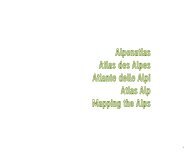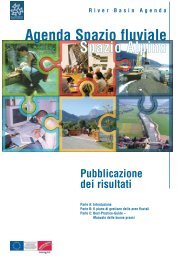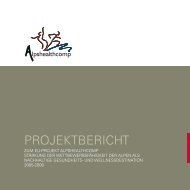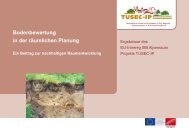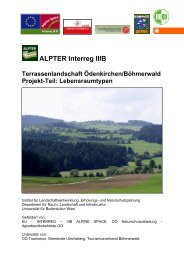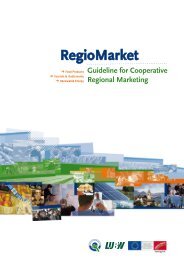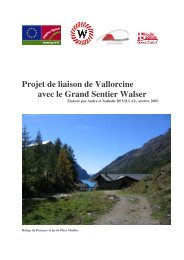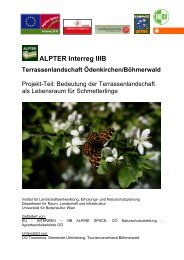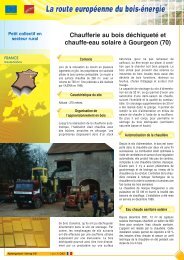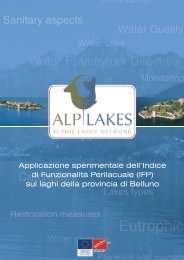WALSERSPRACHE - The four main objectives of the Alpine Space ...
WALSERSPRACHE - The four main objectives of the Alpine Space ...
WALSERSPRACHE - The four main objectives of the Alpine Space ...
You also want an ePaper? Increase the reach of your titles
YUMPU automatically turns print PDFs into web optimized ePapers that Google loves.
Marco Angster<br />
tun eister sieche d chatzò<br />
tue: IND:PRES:1SG PROG “cercare”:INF DEF:SG:F “gatto”<br />
“Sto cercando il gatto”<br />
Queste interazioni, però, non considerate al momento della stesura<br />
del questionario (addirittura l’esistenza della forma progressiva eister non<br />
era citata nella bibliografia consultata e dunque mi era sconosciuta) sono<br />
state esaminate solo superficialmente e meriterebbero un maggior appr<strong>of</strong>ondimento;<br />
in generale, comunque, si può dire che gli elementi suddetti<br />
tendono a favorire l’uso delle forme perifrastiche soprattutto in frasi<br />
nelle quali manchino sintagmi nominali in posizione finale in funzione di<br />
complemento.<br />
Bibliografia:<br />
• Marco Angster, La perifrasi tue + infinito nel titsch di Gressoney, Tesi<br />
di laurea, Torino 2006.<br />
• Silvia Dal Negro, <strong>The</strong> Decay <strong>of</strong> a Language. <strong>The</strong> Case <strong>of</strong> a German<br />
Dialect in <strong>the</strong> Italian Alps, Berna 2004, Lang.<br />
• WKZ, Walser Kulturzentrum, Greschòneytitsch Vocabolario Italiano-<br />
Titsch, Aosta 1988a.<br />
• WKZ, Walser Kulturzentrum, D’Éischemtöitschu Vocabolario Italiano-<br />
Töitschu, Aosta 1988b.<br />
• WKZ, Walser Kulturzentrum, Greschòneytitsch Wörterbuch Titsch-<br />
Deutsch-Italiano, Aosta 1998.<br />
• Peter Zürrer, Wörterbuch der Mundart von Gressoney, Frauenfeld,<br />
Huber 1982.<br />
<strong>The</strong>se findings emerge from a research on <strong>the</strong> Walser dialect from Gressoney. <strong>The</strong> aim<br />
was to analyse periphrastic sentence structures obtained from a combination <strong>of</strong> different<br />
forms <strong>of</strong> <strong>the</strong> auxiliary verb “tue” (“to do”) along with <strong>the</strong> infinitive <strong>of</strong> o<strong>the</strong>r verbs. <strong>The</strong> purpose<br />
was to define <strong>the</strong> various roles it may take on in <strong>the</strong> verbal system <strong>of</strong> this particular<br />
dialect. It was also important to establish to what an extent <strong>the</strong>se forms are well settled in<br />
permanent grammatical patterns. Sentence no. 1 is an example <strong>of</strong> this sentence structure<br />
89<br />
***



